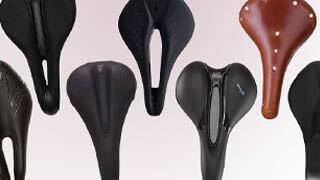Archived
Please note, this page may contain outdated information or subject matter.
How to Find the Right Saddle
Whether you're riding your first full day bike ride or a veteran of endurance events choosing the right saddle can make or break your ride.
The first thing to note is that every rider is different, so everyone will have their own preference but our simple guide should help you find the right saddle for you.

Choosing the Right Shape Saddle
This comes down to how flexible a rider you are. A simple test for this is to try and touch your toes with your legs straight.
Can you touch your toes? If so then you are flexible. If you struggle to bend over then your are not as flexible. This will now give you a starting point.
Typically less flexible riders move around more in the saddle and have a more upright riding position. With this being the case a more rounded saddle shape is best for providing the most all round support. Whilst a flexible rider with a stronger core might not move at all and ride in a more aerodynamic fashion so a flatter saddle would be of more benefit to them.
Remember this is about your flexibility, so buying a flatter saddle won't make you more aerodynamic and fast. In fact it could be far more likely to give you back ache half way through your ride!

How wide?
The most important thing to know when choosing a saddle is your sit bone width. This is the point where the most pressure is exerted when you are riding your bike and as such needs adequate support in the right place.
Most bike shops will be able to assist with this but you can measure this at home.
To do this lay a sheet of tin foil on a table or step and sit on it. Raise your legs slightly and lean forward until you are in your riding position. Then carefully stand back up and measure the two deepest imprints. This is your sit bone width.
Most saddle manufactures will have a size chart on their products that will relate to this measurement such as the chart pictured opposite.
Cuts and Grooves
If you bend forward when you are in your riding position you may find that there is more pressure placed on the front of your pelvic area. This can lead to numbness or pain on long rides but can be relieved with cut outs and grooves.

